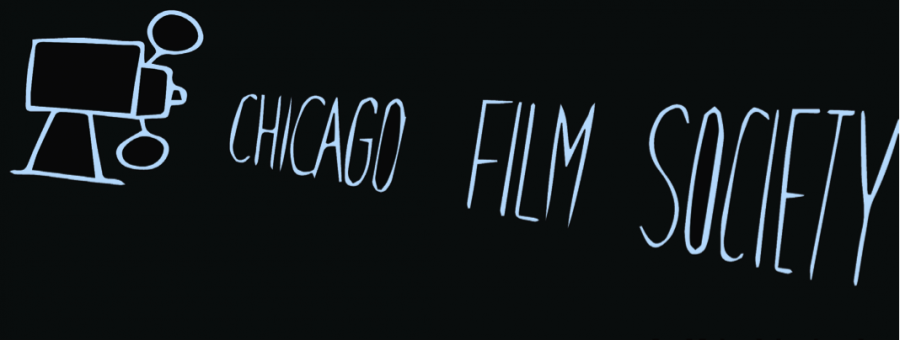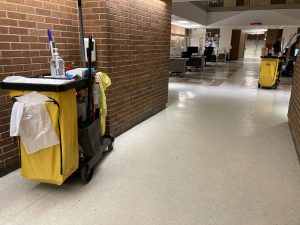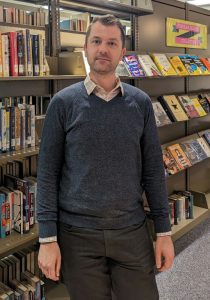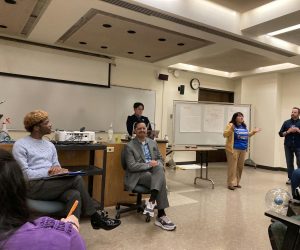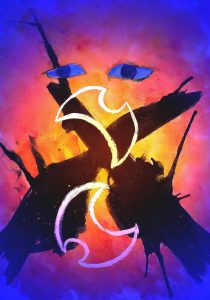Projecting the past: Chicago Film Society revives classics
January 25, 2017
In a perfect world, Claude Monet’s haystack paintings would be accessible to view for everyone in the whole world who wanted to see it, instead of only those who could afford to travel to the Art Institute of Chicago.
Luckily for the NEIU community, film lovers do not need to have this problem with famous (and some not-so-well-known) works of cinematic art. NEIU is home to one of the few organizations screening movies by 35mm film projection (as opposed to digital projection) in the Chicago area, the Northwest Chicago Film Society .
Whereas digital copies of movies are mere approximations of movies on film, even on the highest resolution Blu-ray players, a film projection is akin to viewing actual people and objects move as if through a window. Light filters through a thin chemically treated material (what we commonly call “film”) to shine an image onto a screen. The feeling you get when viewing art in this format is authentic and organic in a way that isn’t quite comparable to streaming a movie on your iPad.
Just as we can’t knock the Interwebs for sometimes being our only access to paintings, we can’t knock streaming or DVDs when it’s the easiest way to see a movie. It’s difficult to find actual film projection screenings, because archival and preservation of physical art objects isn’t cheap.
Yet, you can’t beat the real thing. So with only a handful of other venues showing film projection in our major metropolitan area—Northwestern University, University of Chicago, the Music Box Theatre, Gene Siskel Film Center—we have a hugely impressive treasure right here on our campus. At $2 a pop for students ($5 for the general public), it’s the absolute best deal in town.
Film projection maintains a close connection with the historical lineage of film as an artform with a material nature.
“You’re running things here that are 90 years old—not the content, but the actual object,” said Kyle Westphal, a co-programmer for the Chicago Film Society.
The type of film screening put on by the CFS is one that preserves the actual format a movie was shot, shown in exactly the way the director intended the movie to be seen. What’s more, sometimes the availability of films is strictly limited, meaning that certain movies that have not been converted to home video format can only be seen on 35mm.
I can’t say it enough. Listen up. The Chicago Film Society is the best deal for catching a movie in the city, and it’s right here on our own campus.
What’s more, starting Spring 2017, NEIU students can earn one 300-level credit hour in cinema history for up to three semesters. The Department of Communication, Media and Theatre is offering CMTM-390, “Cinémathèque,” to all movie lovers and wannabe art house film buffs. The course is perfect for ironing out 300-level credit requirement quotas if you need just an additional credit hour. This semester’s course, taught by professor Shayne Pepper, combines five CFS film screenings with online work. The course provides a context for students to watch and discuss films, learn about how films are made, and about their preservation and restoration. In the process, students gain a better appreciation for the form.
You can see Jim Jarmusch’s 1991 classic “Night on Earth” on 35mm film on Febr. 1 and Frank Capra’s 1929 movie “The Younger Generation” on March 8. CMT Instructor, Dr. Nancy McVittie will introduce the March 8 film, a rare Capra movie only available in the 35mm format!
On Feb. 15, you can also see “Puzzle of a Downfall Child” (directed by Jerry Schatzberg, the artist who did the album artwork for Bob Dylan’s “Blonde on Blonde”), which has never been distributed on home video in the United States. The movie has had wider distribution in Europe. Starring Faye Dunaway (of “Chinatown” and “Thelma and Louise”) as a model, this psychological melodrama is one of the screenings I’m most excited for this season.
The full list of screenings can be found at www.neiu.edu/films.


